Photography Tips
by Michael Frye | Jul 17, 2014 | Photography Tips
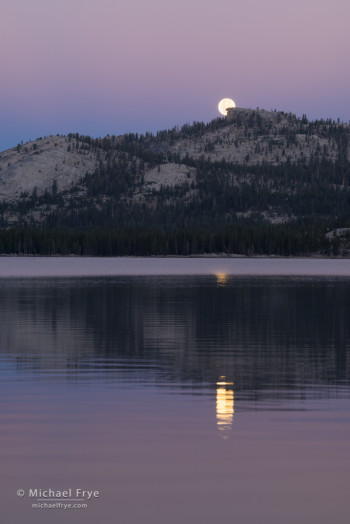
Moon setting over Tenaya Lake, Saturday morning, 5:42 a.m.
“I have always been mindful of Edward Weston’s remark, ‘If I wait for something here I may lose something better over there.’ I have found that keeping on the move is generally more rewarding.”
— Ansel Adams
Sooner or later, every landscape photographer has to decide whether to stay put and hope that the light gets better, or move somewhere else.
Last Saturday morning, on the last day of my Hidden Yosemite workshop with The Ansel Adams Gallery, we rose early and drove to Tenaya Lake to capture the moon setting over the water. On our way there we noticed low-lying mist in Tuolumne Meadows. We photographed a beautiful moonset over the lake, but as soon as the moon dropped below the ridge we drove back to Tuolumne.
The mist was still there. First we ran out to a small pond to catch the sun lighting some small clouds above the high peaks to the east. Then we spotted a herd of deer off to the left in the mist, so we quickly changed lenses and photographed them until they moved away.
By then the sun was hitting Unicorn Peak, so we walked about a hundred feet north to get a reflection of the peak in the pond, and waited until the sun grazed across the foreground.
Then light started hitting the mist and trees behind us, so we moved again to get closer, and put the sun behind trees where we could see sunbeams and starbursts.
And then the sun rose higher, the mist disappeared, and the show was over. The whole sequence lasted about 40 minutes.
In this case, the light and fog were changing quickly, so we had to switch lenses and move our feet if we wanted to catch those fleeting moments. But three years ago, during the same workshop, a similar situation required waiting patiently for the light to change.
(more…)
by Michael Frye | Jun 15, 2014 | Photography Tips
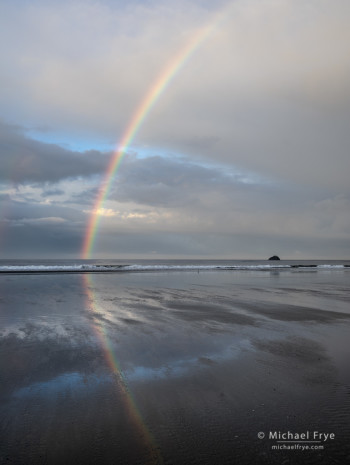
Rainbow, Crescent Beach, Crescent City, CA, USA
It should be obvious that weather and light are important aspects of landscape photography. No matter where you are, it pays to keep an eye on the weather, and to learn local weather patterns.
We arrived in Crescent City about five days before our redwoods workshop was set to begin. Our first night there some showers moved through, and at sunrise it was gray and raining. But online radar and satellite images showed that the showers might end soon, so I prepared to go out. Then through our hotel room window I saw a rainbow! We made a dash for the car, drove out to Crescent Beach, and luckily the rainbow was still there (right).
The weather then settled into a more typical pattern for the season, with frequent coastal fog and low clouds in the mornings, giving way to clear skies in the afternoons. This pattern should be familiar to anyone who has spent time along the California coast in summer.
This fog is the perfect complement to redwood forests. The rhododendrons were also putting on a great display this year, so for the first part of our workshop, and while scouting beforehand, we had beautiful conditions in the redwoods, with fog, rhododendrons, and even sunbeams.
But on the last day of the workshop the wind shifted and pushed the coastal fog offshore. This also happens frequently along the northern California coast, even in summer, as any disturbance in the weather pattern can change the winds and move the fog out to sea. But the offshore wind produced a different kind of fog – valley fog along the Klamath River. I didn’t think we would see valley fog during this visit, because valley fog usually requires damp ground from recent rains, and there hadn’t been much rain in the area. But apparently the river itself provided enough moisture to create fog.
This time the fog flowed along the river toward the sea, and it was local enough, and low enough, for us to get above it near the mouth of the Klamath River. It was a special treat to look out over the fog bank, and then to watch and photograph the sun breaking through the fog and lighting the surf.
(more…)
by Michael Frye | Jun 11, 2014 | Photography Tips
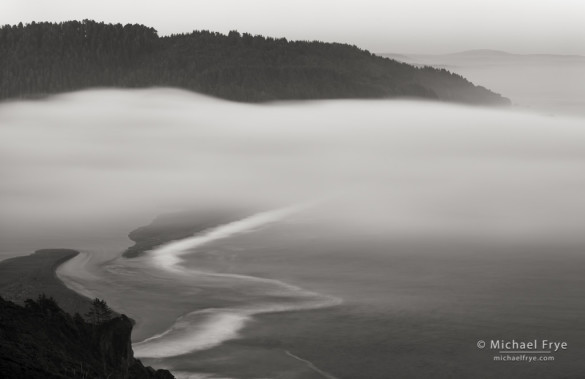
Fog at the mouth of the Klamath River, Redwood NP, CA; 30 seconds
The far northern coast of California has many wonderful, wild coastal areas, providing great opportunities to make moody photographs of ocean scenes. It can be challenging to photograph these scenes, however, because things are constantly changing. In addition to that usual variable – the weather – you have to think about the tides and movement of the waves. Timing can be critical for catching a wave, or pattern of waves, in just the right position, and sometimes you need a lot of patience to wait for the right moment.
Any moving subject – including waves – can lend itself to using slow shutter speeds. With ocean scenes, the blurred motion created by slow shutter speeds can convey a sense of motion more strongly than a frozen image would, or give the water an ethereal quality that adds to the mood of the image. Here’s a small portfolio of my slow-shutter-speed ocean photographs from before, during, and after our workshop, with the shutter speeds included in the captions for each image.
(more…)
by Michael Frye | May 26, 2014 | Photography Tips
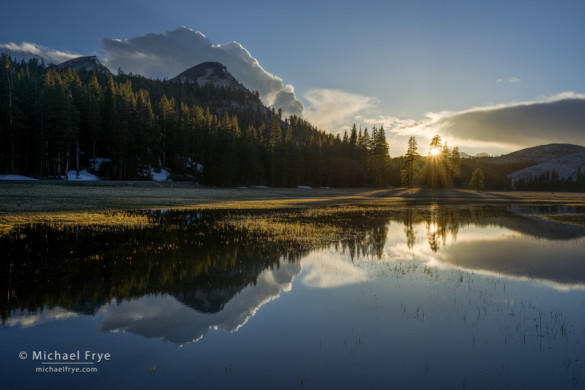
Setting sun, Tuolumne Meadows, 7:39 p.m. Thursday (as the sun sank behind the ridge)
Last week some unseasonal showers reached Yosemite. The showers didn’t bring heavy amounts of precipitation, but enough snow fell at higher elevations to temporarily close Tioga Pass and the Glacier Point Road.
On Thursday the Tioga Road reopened. Since Claudia and I are heading up to the northern coast of California soon for my redwoods workshop, we thought this might be our last chance to go up to the Yosemite high country for awhile, so we decided to drive up to Tuolumne Meadows for the afternoon. There were still some clouds and showers in the area, so the prospect of some interesting weather made the idea even more enticing.
(more…)
by Michael Frye | May 18, 2014 | Photography Tips
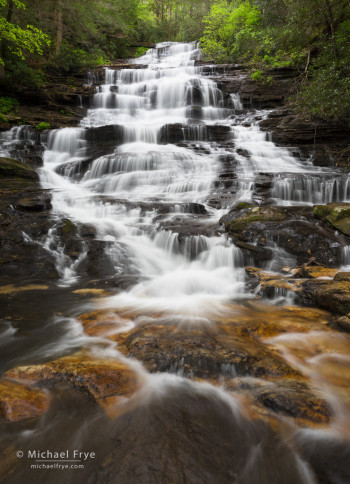
Minnehaha Falls, GA; 1 sec., f/16, ISO 100
Waterfalls are abundant in the southern Appalachians. It seems like you can hardly throw a stick without hitting one.
Of course I’ve spent the last 30 years in Yosemite, which might have the most spectacular collection of waterfalls in the world. But they’re different. Yosemite’s waterfalls are big and dramatic, and often leap hundreds of feet in a single drop. The waterfalls in the southern Appalachians are smaller, more intimate, and more complex, often containing multiple tiers and channels. This complexity can make them both more challenging and more rewarding to photograph – challenging because there’s rarely an immediately-obvious composition, but rewarding because once you start looking you might find a dozen or more good compositions in a single cascade.
During our last trip, one of the first places we visited was Minnehaha Falls in northern Georgia. Since this fall is on the cover of two different waterfall guidebooks it seemed worth checking out. And we weren’t disappointed. Minnehaha is graceful enough to lend itself to overall views, and intricate enough to offer many smaller-scale compositions. The day was overcast, which is often ideal for these kind of waterfalls. I spent an hour and a half there working just one side of the cascade before we had to move on.
(more…)
by Michael Frye | Apr 7, 2014 | Photography Tips
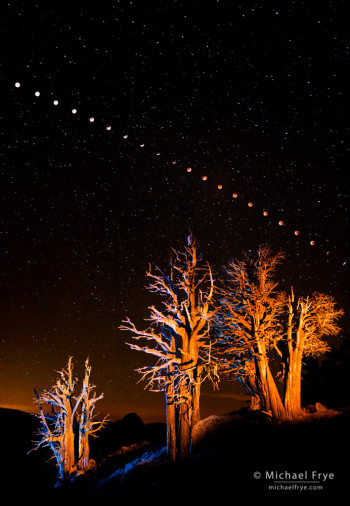
Lunar Eclipse Sequence, 1:23 a.m. to 4:49 a.m., August 28, 2007, Yosemite NP, CA
On the night of April 14th and 15th viewers in North and South America will be able to see a total lunar eclipse. Most people should be able to see the whole eclipse sequence (weather permitting), though viewers in the far northeast will miss the very end of the event.
I’ve photographed several lunar eclipses, and they’re spectacular events to view and photograph. This one is special, however, because it’s the first time I might be able to see the whole eclipse sequence from beginning to end. In California the eclipse will be seen almost due south. This is not a great alignment for Yosemite Valley, though it should be possible to see the eclipse over Cathedral Rocks or Sentinel Rock. But California is a diverse state with many other possible locations, so I’ll be thinking about other possible locations between now and the 14th.
If you’re interested in photographing the eclipse, I’ve written a guest post about it for the Borrowlenses.com blog. Although I’ve posted other articles about eclipses before, this new article is the most complete and comprehensive, with details about focusing in the dark, revised exposure times, how to align the eclipse with a foreground object (like a building, mountain, or tree), and more.
This is one night when I hope the clouds will stay away. 🙂
— Michael Frye
(more…)














